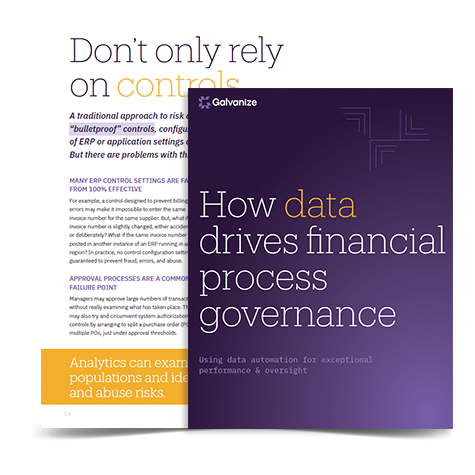Investigating huge sets of data with analytics can bring competitive advantages. But for many organizations, actually harnessing their data is still an aspirational goal.
In this interview, Keith Bailey, Vice President of Finance, Galvanize, shares how finance teams can get started.
What does the popularity of data analytics and big data mean for finance teams?
I generally find that financial planning and analysis (FP&A) teams have heard about the potential of big data analytics, and many are pressuring themselves to take advantage without stepping back and asking themselves what problems they’re trying to solve.
Many organizations are somewhat late to the party. For years, marketers, auditors, sales organizations, and many other business professionals have been effectively using data analytics to uncover patterns to wring greater customer acquisition from expenditures, or detect patterns in financial control breakdown for remediation. Finance leaders are often the issue—they just aren’t interested in, or pressing for, the intelligence gleaned from analyzing huge piles of data.
“Finance teams are uniquely positioned to transform their roles.”
Finance teams have access to massive amounts of organizational data. By analyzing it and uncovering patterns, they can play a major role in addressing risk and pressing ahead with strategy.
If finance teams aren’t already using analytics, where should they start?
Analyzing payments data is by far the easiest and most valuable way to get started with a big-data analysis/opportunity illumination technology like HighBond by Galvanize. It doesn’t matter how tight your financial controls are, or how scrupulously-shaped your ERP processes are—if your organization sees a volume of transactions measured in the millions or billions, there is a 100% certainty that you have fraud, waste, and policy abuse that’s material enough to be concerning.
Analysis of corporate credit card usage is typically fruitful. For commercial businesses with a sales force, regression analysis on the sales pipeline is a fabulous opportunity to add value to the revenue forecasting effort and really bring data analysis to bear on strategy, as is analyzing patterns in customer data.
Once you’ve proven the analytics ROI for a small tactical problem, what’s next for the finance team?
If you follow my advice and make your first foray into data analysis focused on low-hanging patterns in payments data, you’ll find you readily get a mandate to look further. Critically, to move on to more strategic analysis, you’ll need to pursue continuous monitoring. This needs to be done by technology that lets you crunch massive volumes of data routinely and without “hand-holding.” Exceptions, errors, breaches of policy, or outright incidents of fraud need to be remediated automatically. Ultimately, predicting the future is where it’s at when it comes to FP&A’s role in big-data analysis.
Partner with leadership to understand what is important to them and simply start collecting data that nobody else is looking at. If managing cost is an important issue—and it usually is—sources of big data might include things as diverse as elevator maintenance data to predict repairs or fleet management data, again to predict repairs or drive efficiency in usage.
Evaluate how data analytics can make your business impactful.
What advice do you have for equipping a finance team with the skills to develop and maintain analytics capability?
This is something I’m really passionate about. Police forces will tell you that the best investigators are those who are naturally curious; people who just have an inclination to seek patterns. And so it goes for data scientists in the FP&A team. Find those people in your organization who show an aptitude and comfort level with data and technology. See how far you can push the envelope. If you are demonstrating strategic value, you’ll be able to bring in people with specialized skills from outside the team.
Meaningful big-data analytics work really does require time, so you will have to start by being deliberate about carving out time for someone to focus on it. If a data science team already exists within the broader organization, tell them about the data you’re monitoring and ask for their time. Those teams will relish the access to rich transactional data and the opportunity to add value to organizational strategy.
Finally, you talked about identifying anomalies—how do you ensure that dealing with them doesn’t overwhelm other departments?
You’re the experts at determining what is actually impactful to the business. Ask yourself how big the problem really is. Be confident. As I mentioned, take advantage of technology that streamlines both the detection of patterns/exceptions and the actual remediation.
When you observe what looks to be an exciting pattern, don’t just run to leadership with your observations. Usually, the greatest benefit is in going to the teams, the departments, and the people who are in the front lines of creating the data you’re looking at. Bring them opportunities and highlight the risks in what you’re observing. Then, together, take your solutions to leadership for maximum impact. Imagine joining customer service leadership to present a new strategy that could materially improve customer retention.
If you’ve noticed a pattern that indicates strategic-calibre risk, make no mistake: taking the subjectivity out of your argument by presenting analysis of real, transactional data flowing through the business will earn you a seat at the decision-making table.
eBook
How data drives financial process governance
You’ll learn:
- What the world of a progressive finance leader looks like
- The top pressure points affecting today’s finance teams
- Steps to get started with a technology-driven approach to risk and control monitoring
- Examples of common, high-value, high-performing tests that can be applied in everyday finance process areas










